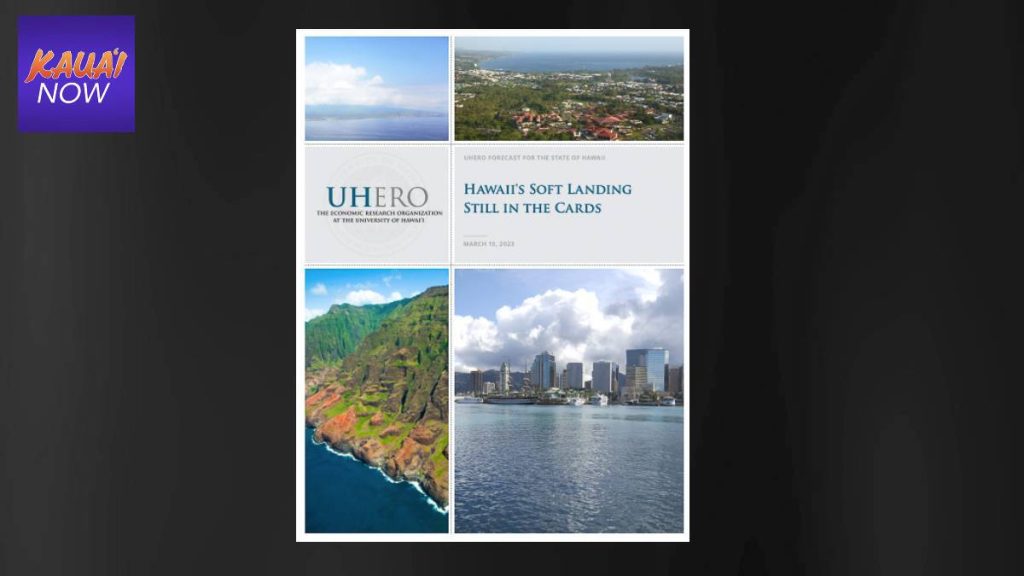UH research report: Hawaiʻi’s economy slowing but no recession

Hawaiʻi’s outlook continues to see economic slowing but no recession, according to the University of Hawaiʻi Economic Research Organization’s first quarter forecast of 2023.
While international tourism will continue to recover, domestic travel will soften as the U.S. economy contracts later this year. Combined with high interest rates and prices, this will cause local growth to weaken through the first half of 2024.
The cooling of inflation in Hawaiʻi and nationally is welcome news. But whether it continues to recede will determine if the Federal Reserve pushes interest rates higher and for longer, which could result in a sharper slowdown in the state.
Highlights of the March 10 report:
- Prospects for the U.S. and global economies have improved somewhat over the past few months. Progress has been made in reducing U.S. inflation without signs of a sharp falloff in economic activity. But still-tight labor markets are challenging the Fed. In Europe, lower-than-expected winter energy prices are softening a slowdown. Globally, China’s restart promises to boost trade over the coming year. Even so, recession risks remain for many countries.
- The tourism industry made substantial progress after last winter’s Omicron-induced lull. Inflation-adjusted visitor spending had fully recovered by the second quarter, and the average daily census did so by September. Recovery of the Japanese market continues to fall short of expectations, rising to just a quarter of its pre-pandemic level.
- Worsening macro conditions mean a more challenging environment for Hawaiʻi tourism this year. U.S. arrivals will decline slightly, even as further international visitor recovery helps offset the overall tourism impact. Restrictions on transient vacation rentals will limit visitor capacity, which could support already-high hotel room rates and other tourism prices even in the face of softening U.S. travel demand. After expanding by more than 4 percent this year, the average daily visitor census will contract by nearly 2 percent in 2024, before a modest pickup. Real visitor spending will also turn from a moderate gain this year to a small decline next year.
- After several years of economic expansion, Hawaiʻi’s labor market continues to make recovery progress. Payroll employment still lags pre-pandemic levels, but tourism-heavy Kauaʻi and Maui counties have now caught up with Oʻahu and the Big island. While overall labor market conditions are no tighter than before the pandemic, some sectors are seeing more acute worker shortages. Recent wage gains have been largest in tourism, where employment still lags pre-pandemic levels by a considerable margin.
- Many sectors will see weaker job growth over the next two years. There will be some firming of growth as we move into 2025. The construction industry has notably healthy prospects, with a very large stock of public construction projects in the works. This strength will offset some of the drag coming for the weakening domestic visitor industry.
- Education losses during the pandemic disproportionately burdened students from lower income households, raising concerns about increased future income inequality. A number of plans announced in the governor’s State of the State address would address such concerns, including income tax reform and various housing initiatives.
- Inflation in the islands has been less severe than on the U.S. mainland, but has still taken a big bite out of purchasing power. Together with the effects of the ending of pandemic support programs, we estimate that real personal income declined more than 6 percent last year. As inflation continues to recede — averaging about 3 percent for this year overall — real income will pick back up, firming to the 2 percent range by 2024–25.
“The near-term outlook is not without risks, particularly more aggressive Fed tightening,” said Carl Bonham, executive director of the UH Economic Research Organization. “Still, our state’s relatively healthy footing puts us in a position to begin the hard work of addressing longer-term challenges. These include the visitor experience, questions of tourism capacity, housing cost and availability, our aging population and adjustment to climate change.”
To see the entire forecast, click here.
Sponsored Content
Notice: Function the_widget was called incorrectly. Widgets need to be registered using
register_widget(), before they can be displayed. Please see Debugging in WordPress for more information. (This message was added in version 4.9.0.) in /mnt/efs/html/wp-includes/functions.php on line 6114




